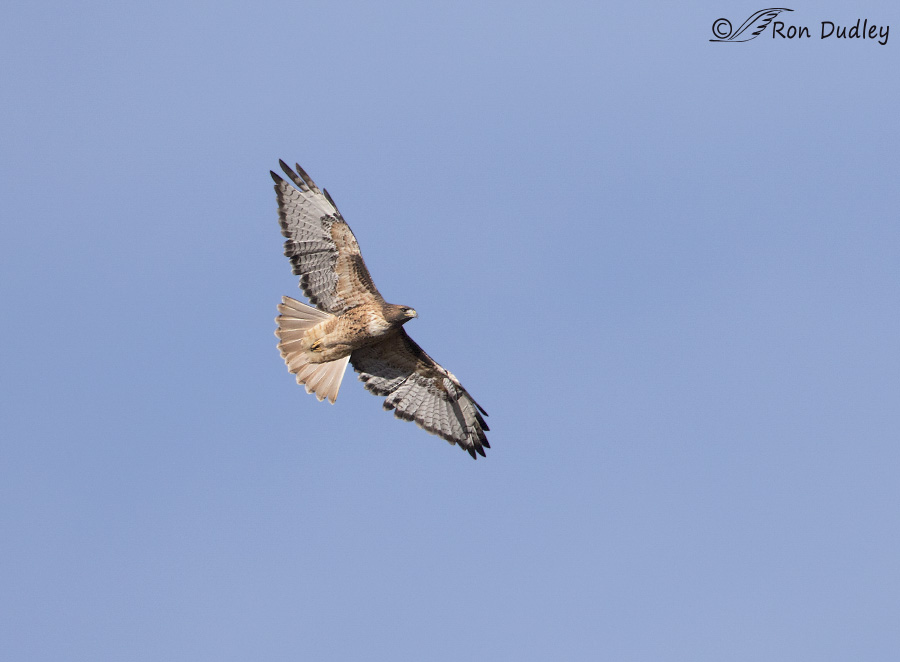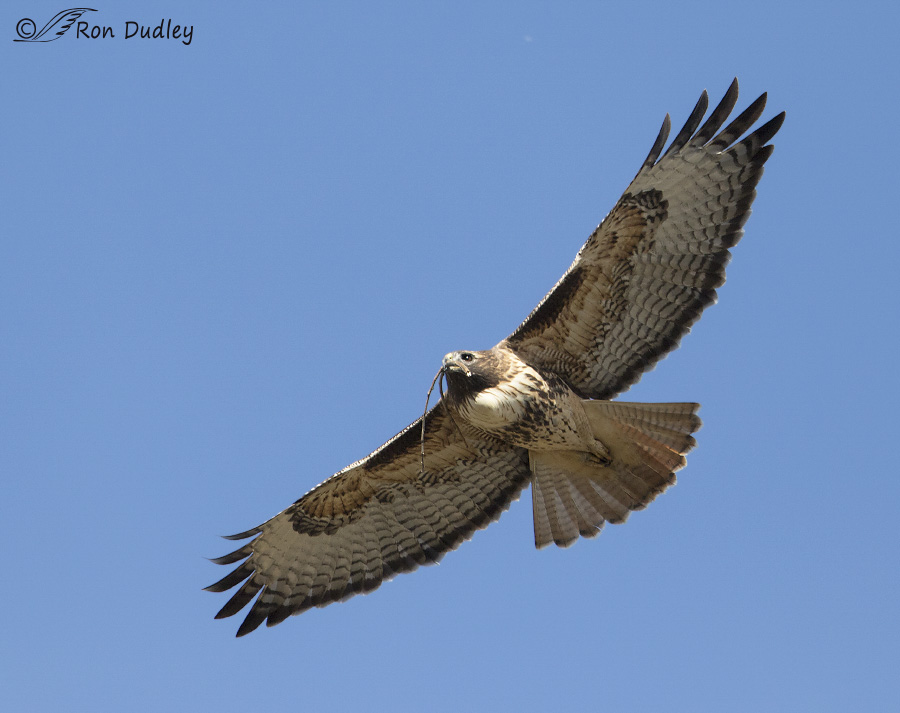Raptors carrying nesting material in late fall is something I rarely see or photograph.
 1/5000, f/6.3, ISO 500, Canon 7D Mark II, Canon EF 500mm f/4L IS II USM, not baited, set up or called in
1/5000, f/6.3, ISO 500, Canon 7D Mark II, Canon EF 500mm f/4L IS II USM, not baited, set up or called in
On October 27 of this year I photographed a pair of adult Red-tailed Hawks cavorting with each other near Farmington Bay – this bird is one of them. They were soaring high in the sky and this hawk never came in close to me so the image has little detail but I thought I’d include it so readers can see both birds. The two hawks were obviously interacting with each other in a nonaggressive manner.
 1/2000, f/6.3, ISO 500, Canon 7D Mark II, Canon EF 500mm f/4L IS II USM, not baited, set up or called in
1/2000, f/6.3, ISO 500, Canon 7D Mark II, Canon EF 500mm f/4L IS II USM, not baited, set up or called in
This is the other hawk and as you can see it was carrying nesting material as it soared and “played” with its apparent mate.
In my experience this behavior so late in the year is unusual but not unheard of. I believe I’ve read in the past that some raptor species occasionally do this to maintain the pair bond through the winter. Non-migratory Red-tailed Hawks usually remain mated until the death of a partner so it makes sense.
Bird behaviors are fascinating and it feels oh so good to get back to them after my recent hiatus.
Ron


Ah, so good to find my favorite raptor so beautifully photographed by you! And I love Neil’s description of the 4 pairs who flew together — what a sight that must have been! Because of Ezra & Big Red (as well as Central Park’s Pale Male and his mates), I knew RTHAs pair-bonded, but the idea that they may maintain extended relationships (family? friends?) thrills my anthropomorphic heart! Even as my brain says that’s crazy. 😊 Thanks for the post, Ron.
I really enjoyed Neil’s anecdote too, Chris. I wish I’d seen it!
Majestic. Beautiful, heart-stirring.
Quite a lot of birds do mate for life – and seem to do it better than the humans.
Welcome back – and thank you.
“Quite a lot of birds do mate for life”
Exactly, EC – many, many species do just that, though there are many variations on the theme. Some monogamous bird species cheat, and some “divorce” — but at rates much lower than humans. No surprise there…
As a pre-teen I raised pigeons and the long-term devotion of mates was impressive to me even back then.
Great shots Ron!
We have two mated Eastern Red-tails here, and I was asked, after someone saw the two of them fairly close to each other on a branch, Isn’t the closeness unusual? I said no, they mate for life and there needs to be interaction during the off season so that the pair bond is maintained. She didn’t realize they mated for life, and that fact caught her interest! I’m not sure the average person realizes that some birds do mate for life just like some of us humans! VBG!
“I’m not sure the average person realizes that some birds do mate for life just like some of us humans!”
That made me smile, Dick, partly at myself as I’m twice divorced – the last divorce was over 25 years ago. I’m a slow learner but I finally figured out that my destiny is to be single and I’m just fine with that…
VBG, I really wasn’t trying to poke fun, but it seems that some people just have little to no natural conception of what goes on in the natural world around them. If I wasn’t a teacher and naturalist I might have been one of those people, and that horrifies me.
Welcome Back to snowy Northern Utah, Ron.
I’m sure your avocation helps as a distraction from the angst that accompanies Shannon’s injury. I hope her recovery progresses unabated.
My first experience with pair bonded RTHs (not nesting) was during the migration this fall. 8 individuals in the sky at the same time split into 4 pairs almost equally spaced, covering about a mile of terrain, cooperatively hunting. One would kite in place while the other would cruise close to the ground trying to dislodge pry. Two of the pairs were successful with this strategy and shared the meal with the partner while I was observing the behavior. All 8 seemed to be traveling together, but the pairs did not encroach on any of the others hunting areas or attempt to poach the kill of the others. I wonder if the bonding extends beyond the pairs and includes an extended family? Thanks for confirming what I witnessed. My education continues.
Neil, the snow and cold rain felt and looked good this morning after my Florida experience, even though it ruined the light for my morning shoot today.
Wow, I’d love to have witnessed what you did with four red-tails. Thanks for sharing your experience.
Ron,
I always look forward to starting my day with one of your beautiful pictures. It’s good to have you back. John
I love knowing that my posts are part of my reader’s morning routines, John. Thanks for saying so.
Great shots! Thank you for sharing them w/us.
Linda
I’m glad you enjoyed them, Linda.
What a magnificent pair! I’ll never understand those who would barely give these birds a glance because they’ve already “ticked” them off on a checklist. I could be very content watching them soar, hunt and interact 24/7.
Thanks for bringing us such beauty, Ron!
Wally, I know a bird photographer that mostly ignores red-tails because they’re so common in his area. Different strokes I guess…
It’s fascinating that these birds would do something specific to maintain their pair bond. That’s something I’ve never heard of before. These shots are beautiful, and it feels very good to be able to see your posts early in my morning again.
It feels very good to be back at it, Susan. Thanks for missing me…
Wonderful shots, Ron.
Thanks, Christina.
Those are very solid-looking, healthy-looking biirds…interesting comments on interesting behaviours, especially the nesting behavious. Welcome back….We’ve missed you!!!
“healthy-looking birds”
Agreed, Patty and part of that is probably because they’re eating well. Check out the bulging crop of the hawk in the second image.
That’s the one I noticed first…at least one less vole!
Really great shot of the one with nesting material.
Thanks, Arwen.
A few years ago we had been watching a pair of Red Tailed Hawks not far from us. They built their nest about this time of year. The female sat by the nest at all times, while the male was not to far away in his favorite tree. Once she laid her eggs, then the male stayed right by the nest. They are such beautiful and interesting birds. Wonderful pics Ron!
Interesting, Jean. And thank you.
Like Christine said, we’ve witnessed continuous bonding behavior with Big Red and Ezra. When I was coming up, I was taught that they don’t interact other than nesting time and that’s just not true with a bonded pair. I would also guess that they hunt cooperatively sometimes although we haven’t yet seen that. But bonding behavior goes on all during the winter. Through the folks on the ground, like Christine and Karel and Cindy Sedlacek who do daily Livestreaming, we’ve learned a lot about what redtails do that the experts said was impossible!!
Years ago I worked for the Wa State DOT. I was an unlicensed engineer like so many others that built the Interstates in WA.
We had a daffition of “expert” which is still good I think.
EXPERT >> EX SPURT = EX is a has been & SPURT is a drip under pressure so together a “HAS BEEN DRIP UNDER PRESSURE”
Welcome back Ron
Your comment made me smile, David. Thanks for that!
Laura, as you well know we can learn a lot about their behavior if we only pay close attention. And think about what we see.
I also wasn’t aware that they are monogamous. It is interesting that they’d be doing nesting behaviors later in the season possibly as a bonding behavior. Nice shots – plumage detail is great! 🙂
I’m glad you enjoyed the images and learning something new about the species, Judy.
Welcome back.
Thanks, Judy.
So great to have you back to posting Ron, but I know that your heart remains heavy. FYI: “Our” local RTHAs that preside over the Cornell campus stay together all year round 😉 Ezra and Big Red’s pair bond is quite strong–they often exhibit nesting-type behavior during the off season. They even visit their favorite nesting sites on campus and shuffle around the nesting material now and then! You can see their most recent visit on the nest cam: https://www.youtube.com/embed/IcPwn5iTZPw?rel=0
Happy trails and hope to see more photos of your RTHAs, Christine
Interesting, Christine. I know that you follow Ezra and Big Red very closely so your observations and link are very relevant to this post. Thank you.
They are great shots and interesting behavior. I didn’t know they mated for life either.
Charlotte
Thanks, Charlotte. Yup, they’re monogamous and unless one bird of the pair dies the pair bond is maintained from year to year.